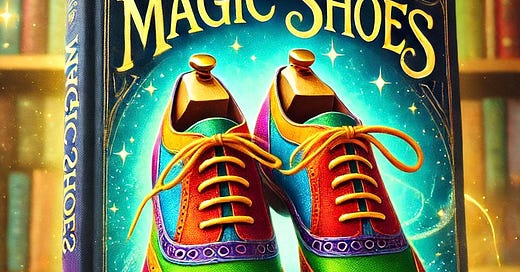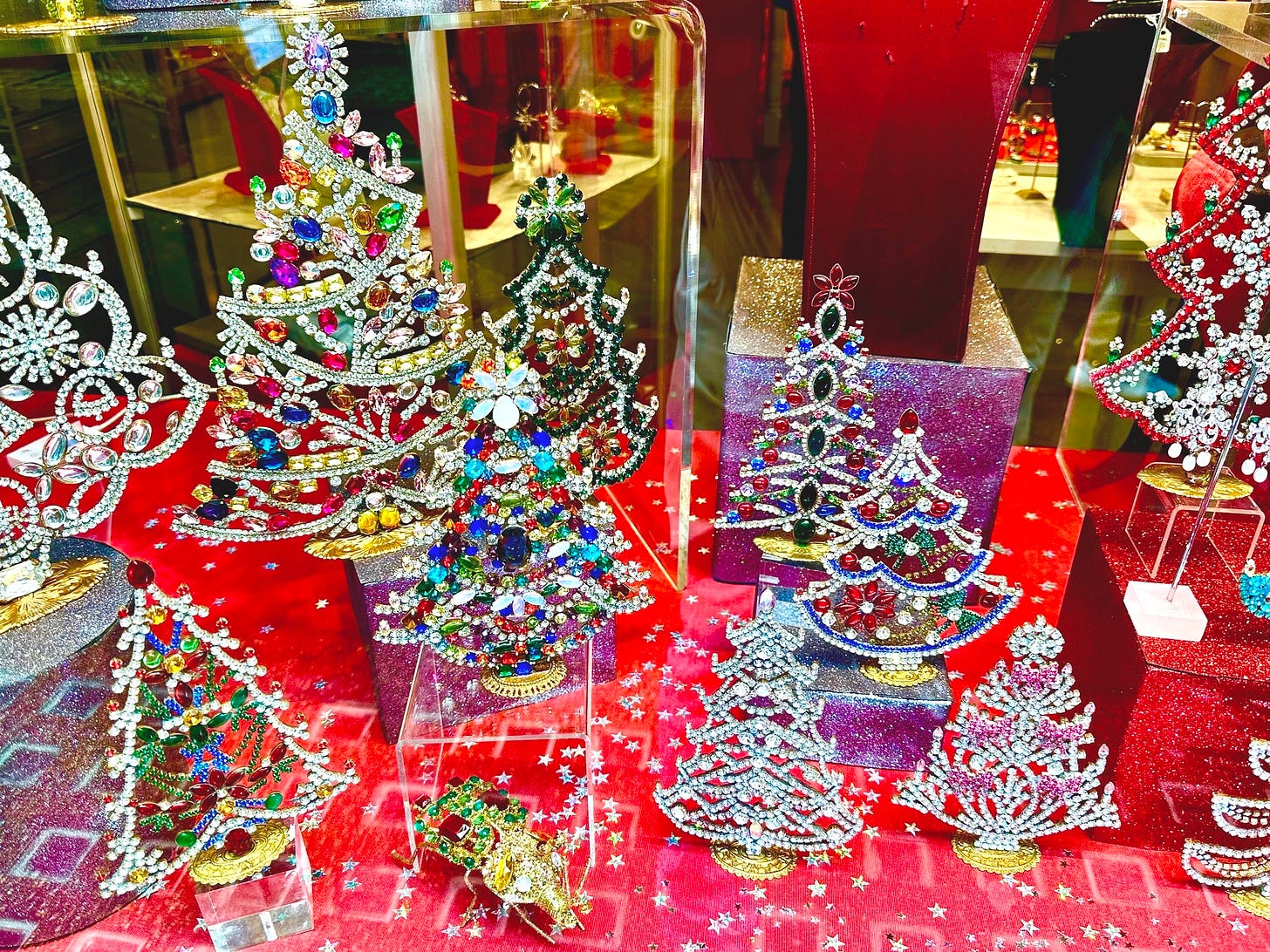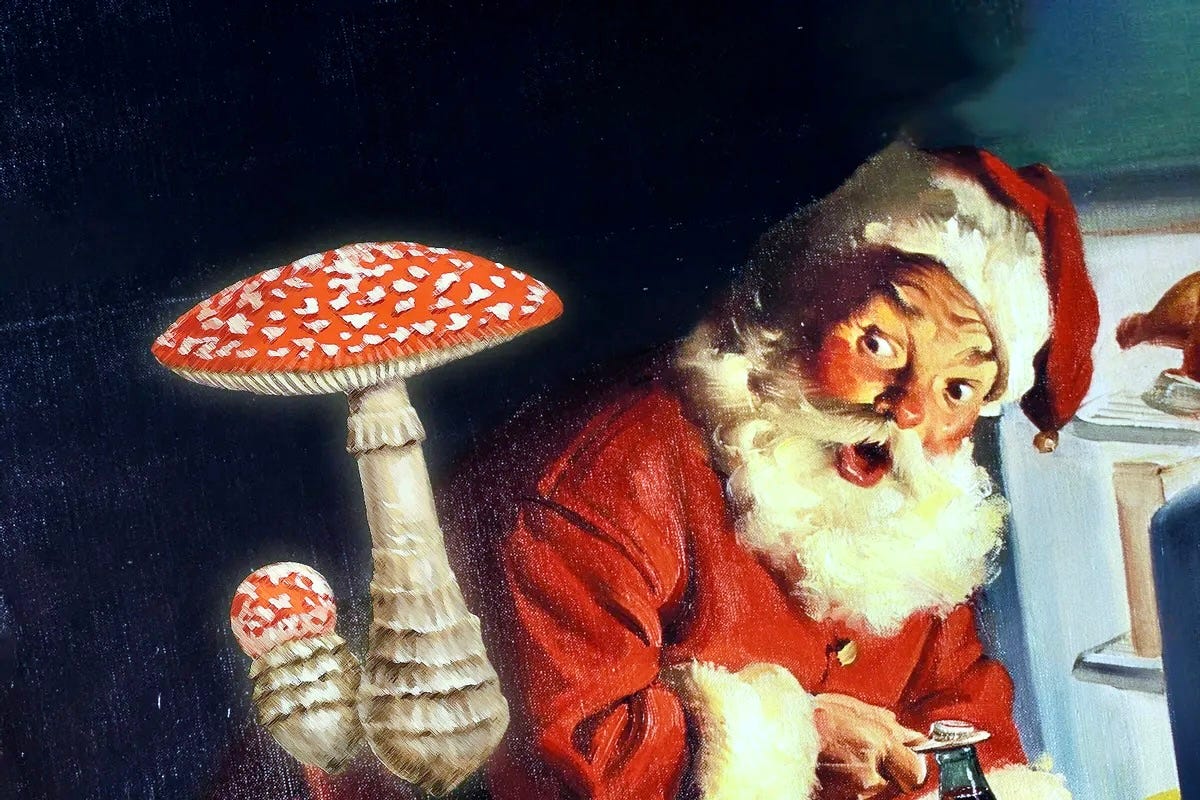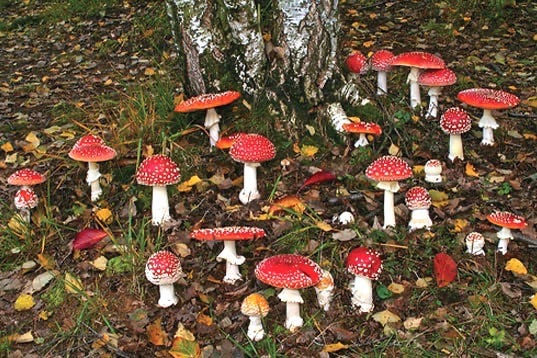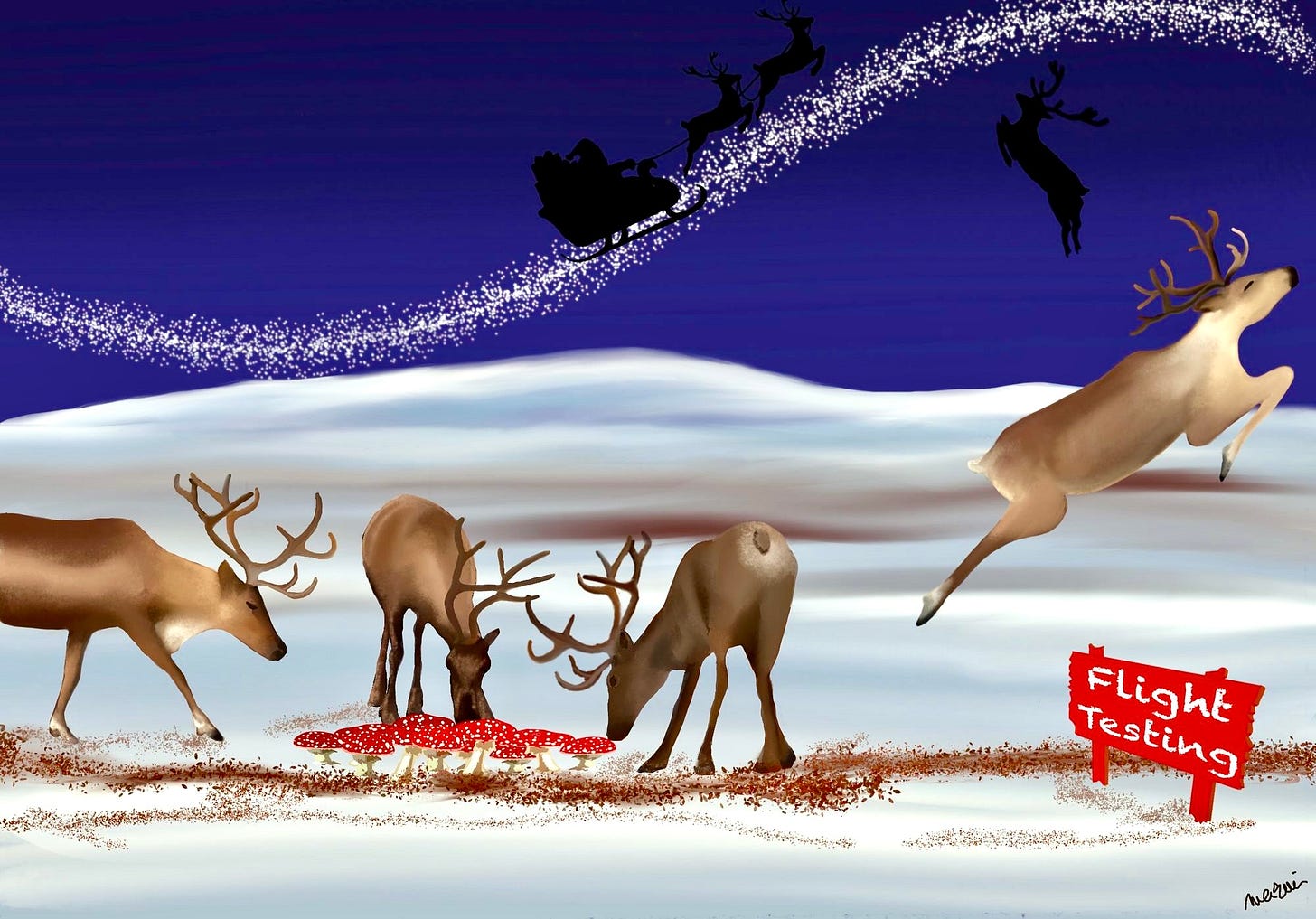Elle provides rubber galoshes coated in reindeer hide to wear over my magic shoes. I follow her from the warm cabin back into the crisp biting air of the Inari wilderness. A hushed, serene quiet is broken only by snow crunching underfoot, birds shifting in their nests and the rustle of branches.
As we walk, I breathe the clean scent of pine sap, mingled with woodsmoke from distant cabins.
She silently leads me down a winding trail that leads to a timeless clearing. We pass a cluster of reindeer, their thick winter coats glistening with frost.
A town nestled along the edge of a frozen expanse soon comes into view.
“Lake Inari,” Elle says.
Low wooden houses line the roads. Heavy with snow and icicles, their roofs glint in the pale sunlight. Wisps of smoke curl from chimneys. The scent of burning birchwood and fresh bread emanates from a bakery glowing with warm golden light.
Further on, vibrantly colored shops of blue, red and green display, in frosted windows, woolen scarves, mittens and reindeer fur boots.
“Sami handicrafts,” Elle explains.
“Sami?”
“This region is home to the Sami.”
As we move onward into this enchanting town I hear the laughter of children and joyful chanting or humming in the distance, and I perk my ear in puzzlement.
“That’s a joik,” she says softly, her voice almost reverent.
“A joik?” To me it sounds like jerk spoken with a New York accent.
Elle nods, her gaze distant. “A joik is… well, it’s not about lyrics or a tune. A joik isn’t meant to describe something—it’s meant to become it.”
I do not comprehend. “To become it?”
Elle’s lips curve into a gentle smile. “When we joik, we don’t simply sing about a person, a place or even a memory. We call up its spirit, its essence. Some say it’s like painting with sound,” she adds. “Others say it’s a way of keeping souls close. You joik someone not to sing to them, but to embody them. You feel them as part of yourself.”
As I try to understand this, Elle suddenly stops. “We are here.”
“Where?”
“The Sami Museum Siida.”
The museum isn’t grand or imposing; its low, sloping eaves blend seamlessly into the surrounding landscape, as though it grew out of the forest itself.
Elle gestures toward the doorway. “Inside, you will find our history—tales of our land, our people and the spirits that have always watched over us.”
Ancient Sami symbols are carved into the wooden entrance through which we step, greeted by an herbal scent. The space is dimly lit. Shafts of light illuminate glass display cases of Sámi culture: ancient tools, colorful woven garments identified as gákti and intricately hand-crafted silver jewelry.
Elle guides me toward a large tapestry on the wall. Its intricate design is mesmerizing—spirals and symbols that seem to dance as if alive with hidden meaning.
“Every thread tells a story,” Elle says softly, her voice filled with reverence. Her eyes trace the pattern with familiarity. “Our ancestors, our land, the cycles of the sun and stars. Each symbol carries the memory of who we are, where we’ve been.” She turns to me. “This, I believe, is part of what the forest wanted you to see. To understand how deeply we, all of us, are connected—to the earth, to time, to each other.”
Elle turns and leads me deeper into the museum. She stops before another display filled with ordinary yet mystical objects: a worn leather pouch, a carved wooden cup, small bundles tied with twine and a shard of reindeer antler etched with intricate looping symbols.
“These are the tools of the noaidi,” she says. “The shamans. Each item carries its own power and connection to the spirit world. The pouches held herbs and powders used in rituals. The cup, called a guksi, is for drinking Chaga tea, brewed to strengthen the body and mind.
“Long before this building existed,” Elle continues, “the Sami people held a bond with the earth—a bond than went deeper than words or even knowledge. This place, this forest, has always watched over us.” She pauses. “The Sami understood that the forest, the lakes and the mountains were alive and filled with guardians. They protected us and offered guidance. Among these spirits, the reindeer held a place of honor. They carried us, fed us, clothed us—and they carried our messages between the human world and the unseen.” She motions at the antler etched with symbols. “This is an ancient Sami calendar, marking the cycles of light and dark and the passage of seasons. It was a guide for the noaidi, the shamans, who journeyed with the help of the forest’s gifts.
“One of these gifts was a mushroom we call gahpir that grows beneath the pine and birch. It is said that those who consume the gahpir—also known as Amanita muscaria—can enter the spirit realm, traveling between time and space.” Her eyes meet mine. “Our shamans used it to see beyond, to speak with ancestors…”
“Yup, been there, done that,” I sardonically interject, recalling where my new Magic Shoes had taken me earlier.
“…and to learn the wisdom of the land.”
This intrigues me. “How so?”
“In the depth of winter, when the nights were longest,” Elle explains, “the shamans would gather and drink Chaga tea to cleanse their minds. Then they would take the red and white cap gahpir and enter a state between sleep and waking. They spoke with spirits of the animals and learned the secrets of the seasons.”
My thoughts drift back to the rhinestone trees I had been admiring on Cecil Court just before I landed here, to their sparkly branches, which had seemed so vibrant and alive and… psychedelic.
Elle’s gaze upon me sharpens, her lips curving into a knowing smile.
“This story—the mushroom, the trees of the forest, the reindeer, the spirit journeys—is where Christmas comes from. The red and white cap of the gahpir, the reindeer who fly in the shaman’s vision. This is the true story and spirit of Christmas.”
I lean in closer. “Please tell me this story.”
Elle gestures for me to take a seat on a low wooden bench nearby and sits beside me. “Shall I begin with the legend of Santa Claus?”
I nod, captivated.
“The red and white of the mushroom is echoed in Santa’s suit. It reflects the gahpir’s vibrant cap.
“When the noaidi, the shamans, were called upon to connect with the spirit world, they wore their ritual attire of red and white garments, like the mushroom itself. To honor the spirits, they would consume the Amanita muscaria mushroom to induce hallucinations and enter a trance-like state.
“And just as Santa visits homes, our shamans would enter family tents or huts through a roof opening in winter, especially when snow blocked the doors. They would deliver blessings or messages to their communities. Santa Claus is a modern shaman figure that transforms the ordinary world with his magical, otherworldly presence.
“Where do you place your gifts at Christmas?” she asks.
“Under the tree.”
“Exactly.” Elle nods. “Our mushrooms grow beneath evergreen trees. The Sami consider them sacred gifts from the forest—presents beneath the holiday tree.
“Amanita muscaria’s colors—red and white—are symbols in themselves. You use these colors in your celebrations, such as red ornaments. The spirit of the mushroom, of the land, lives on in ways modern people have forgotten.”
“Now, the reindeer. As I mentioned earlier, they are sacred to us. Reindeer are known to eat the Amanita muscaria mushroom, and their behavior changes—some say they ‘dance’ or seem to float, freed from the earth. This might sound familiar, yes? Your ‘flying’ reindeer come from tales that began in our forests. The reindeer were uplifted by magic. Or perhaps, under the mushroom’s influence, people envisioned the reindeer this way.”
Elle’s face grows more serious as she leans in. “The mushroom is more than a fungi; it is a bridge. When the noaidi consumed Amanita muscaria, they entered a state of vision. They connected to the spirit world seeing beyond what ordinary eyes could perceive.”
Her gaze deepens, as though she herself is seeing beyond. “The solstice rituals we celebrate honor this transformation. They mark our connection to the spirit world, to our ancestors and to the land. It is a time of renewal, a celebration of daylight returning after the darkest hours.”
She rests her hand on mine with unwavering eyes. “The magical spirit of Christmas, and its joy in the dark of winter, stems from the mystical roots in our land. It comes from the ancient ties between people, spirits and nature.”
Suddenly, I’m seeing Christmas for the first time. It is neither a commercial nor a dogmatic holiday, but an ancient tradition in which the red and white of the mushroom, the evergreens, the reindeer are all woven together.
As Elle finishes, a quiet settles over us. I am in awe of what she has imparted on me.
“Come,” Elle says, rising. “There is something else you need to see.”

